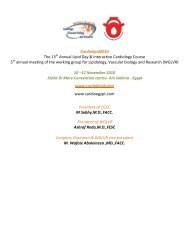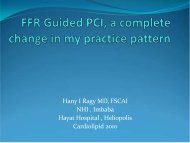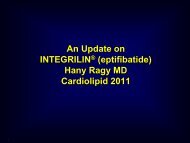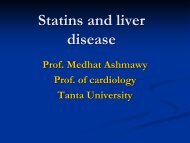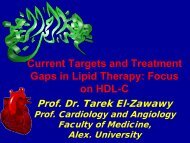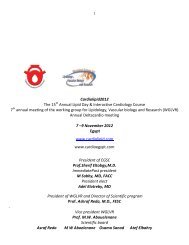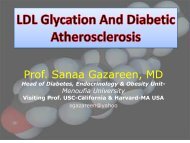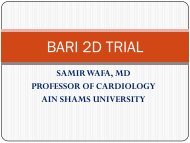Statin/Ezetimbe Combination Therapy: Emerging Evidence
Statin/Ezetimbe Combination Therapy: Emerging Evidence
Statin/Ezetimbe Combination Therapy: Emerging Evidence
Create successful ePaper yourself
Turn your PDF publications into a flip-book with our unique Google optimized e-Paper software.
<strong>Statin</strong>/<strong>Ezetimbe</strong> <strong>Combination</strong><br />
<strong>Therapy</strong>: <strong>Emerging</strong> <strong>Evidence</strong><br />
Ihab Attia, MD<br />
Prof. of Cardiology<br />
Ain Shams University
Nonfatal MI and CHD Death<br />
Relative Risk Reduction, %<br />
Correlation Between LDL-C Lowering and<br />
Decreased CHD Risk According to Treatment<br />
Modality in a Meta-Regression Analysis 1,a<br />
100<br />
80<br />
60<br />
40<br />
20<br />
0<br />
–20<br />
15 20 25 30 35 40<br />
LDL-C Reduction, %<br />
London<br />
Oslo<br />
MRC<br />
Los Angeles<br />
Upjohn<br />
LRC<br />
NHLBI<br />
POSCH<br />
4S b<br />
WOSCOPS b<br />
CARE b<br />
LIPID b<br />
AF/TexCaps b<br />
HPS b<br />
ALERT b<br />
PROSPER b<br />
ASCOT-LLA b<br />
CARDS b<br />
Reprinted from Journal of the American College of Cardiology, 46(10), Robinson JG, Smith B, Maheshwari N, et al, Pleiotropic effects of statins: benefits beyond cholesterol<br />
reduction? A meta-regression analysis, 1855–1862, Copyright © (2005), with permission from Elsevier.<br />
CHD=coronary heart disease; MI=myocardial infarction; MRC=Medical Research Council; LRC=Lipid Research Clinics; NHLBI=National Heart, Lung, and Blood Institute;<br />
POSCH=Program on the Surgical Control of the Hyperlipidemias; 4S=Scandinavian Simvastatin Survival Study; WOSCOPS=West of Scotland Coronary Prevention Study;<br />
CARE=Cholesterol And Recurrent Events Trial; LIPID=Long-term Intervention with Pravastatin in Ischaemic Disease; AF/TexCAPS=Air Force/Texas Coronary Atherosclerosis<br />
Prevention Study; HPS=Heart Protection Study; ALERT=Assessment of LEscol in Renal Transplantation; PROSPER=PROspective Study of Pravastatin in the Elderly at Risk;<br />
ASCOT-LLA=Anglo-Scandinavian Cardiac Outcomes Trial–Lipid Lowering Arm; CARDS=Collaborative Atorvastatin Diabetes Study.<br />
Estimated change in the 5-year relative risk of nonfatal MI or CHD death associated with mean LDL-C reduction for the diet, bile-acid sequestrant, surgery, and statin trials (dashed<br />
line) along with the 95% probability interval (shaded area). The solid line has a slope=1. The crude risk estimates from the individual studies are plotted along with their associated<br />
95% confidence intervals. The Sydney trial is not shown but was included in the analysis.<br />
a<br />
Analysis included 19 trials of high-risk primary prevention and secondary prevention (CHD, cardiovascular disease, renal transplant, diabetes) patients; b <strong>Statin</strong> trials.<br />
1. Robinson JG et al. J Am Coll Cardiol. 2005;46(10):1855–1862.
Recommendations for Lipid Analyses as<br />
Treatment Target<br />
LDL-C remains<br />
the primary target<br />
of therapy in most<br />
strategies of<br />
dyslipidemia<br />
management<br />
ESC/EAS GUIDELINES. Zˇ eljko Reiner et al. European<br />
Heart Journal (2011) 32, 1769–1818
LDL-C Treatment Goals<br />
ESC/EAS<br />
2011<br />
Guidelines<br />
Very high CV risk<br />
LDL-C goal is
Cholesterol Goal Attainment<br />
in Egypt Real World (Labs)<br />
Slide 5
% of patients<br />
Cholesterol Goal Attainment in Egyptian Real World<br />
Majority of Patients on a <strong>Statin</strong> monotherapy<br />
100%<br />
90%<br />
80%<br />
87%<br />
Base = 3036<br />
Patients<br />
70%<br />
60%<br />
50%<br />
40%<br />
30%<br />
20%<br />
11%<br />
10%<br />
0%<br />
(n=2645)<br />
(n=339)<br />
2%<br />
(n=52)<br />
<strong>Statin</strong>s Fibrates Others<br />
Slide 6
Cholesterol Goal Attainment in Egyptian Real World<br />
Vast Majority of Patients on <strong>Statin</strong>s monotherapy failed to<br />
achieve the recommended LDL goal (by risk/goal)<br />
% of pts reaching at goal<br />
20%<br />
17.1%<br />
16%<br />
12%<br />
8%<br />
7.6%<br />
5.50%<br />
8.1%<br />
4%<br />
0%<br />
0.80%<br />
(n=2183) (n= 434) (n= 419)<br />
DM alone CHD alone DM + CHD<br />
0.70%<br />
< 100 mg/dl < 70 mg/dl<br />
*LDL-C goal of
Cholesterol Goal Attainment in Egyptian Real World<br />
Results Summary<br />
• Most patients received statins as<br />
initial therapy<br />
• Approximately 91% did not achieve their<br />
cholesterol target goal<br />
• Egyptian goal attainment data seem to be less than the worldwide<br />
data<br />
Slide 8
Why do statins alone don’t<br />
get our patients to where we<br />
want ?<br />
Slide 9
Reduction of LDL-C, %<br />
Doubling a <strong>Statin</strong> Dose Yields Only<br />
a 6% Incremental Drop in LDL-C<br />
<strong>Statin</strong> Rule of 6<br />
6% drop<br />
6% drop<br />
6% drop<br />
0 10 20 30 40 50 60 70 80<br />
<strong>Statin</strong>, mg<br />
Adapted from Knopp RH. N Engl J Med. 1999;341:498–511; Stein EA. Am J Cardiol. 2002;89(suppl):50C–57C.<br />
10
<strong>Statin</strong>s Adverse Events<br />
• Hepatotoxicity (0.1% - 2.7%)<br />
• Myopathy/Myaligia (1% - 7%)<br />
• Rhabdomyolysis (1% - 2%)<br />
They occur when :<br />
1. Larger <strong>Statin</strong> doses<br />
2. Pre existing liver disease<br />
3. Use of associated hepatotoxic substances<br />
4. Concurrent use of cytochrome 450 inhibitors<br />
5. Lipophilic<br />
11
Elevated Transaminases<br />
(% of Patients)<br />
% Decrease in LDL-C<br />
Risk:Benefit Ratio of<br />
<strong>Statin</strong>Titration<br />
Atorvastatin<br />
Lovastatin<br />
Simvastatin<br />
0<br />
10 mg 20 mg 40 mg 80 mg<br />
20 mg 40 mg 80 mg<br />
40 mg 80 mg<br />
-10<br />
-20<br />
-30<br />
-40<br />
-50<br />
-60<br />
2.5<br />
2.0<br />
1.5<br />
1.0<br />
0.5<br />
0.0<br />
10 mg 20 mg 40 mg 80 mg<br />
20 mg 40 mg 80 mg<br />
40 mg 80 mg<br />
Data from prescribing information for atorvastatin, lovastatin, simvastatin.<br />
This does not represent data from a comparative study.
Severe Adverse Event Rates for Each Trial:<br />
Meta-Analysis of Intensive vs Moderate <strong>Statin</strong><br />
<strong>Therapy</strong><br />
Cannon CP et al. JACC 2006;48:438–45
Inter-individual variability in<br />
response to statins<br />
Extrinsic factors<br />
(extraneous influences)<br />
Intrinsic factors<br />
(genetically-determined)<br />
poor compliance<br />
background diet<br />
dose and uptitration of drug<br />
concomitant drug therapy<br />
LDL-receptor gene mutations<br />
apo-B-100 gene mutations<br />
rate of cholesterol biosynthesis<br />
rate of cholesterol absorption<br />
CYP/Transporter polymorphism<br />
CETP polymorphism<br />
apoE polymorphism
INHIBITION OF CHOLESTEROL SYNTHESIS RESULTS IN A HIGHER<br />
ABSORPTION RATE OF CHOLESTEROL FROM THE INTESTINE*<br />
HEPATIC<br />
BIOSYNTHESIS<br />
INTESTINAL<br />
ABSORPTION<br />
Inhibition of<br />
cholesterol synthesis<br />
(simvastatin 10-80 mg)<br />
Food<br />
STATINS<br />
30-50% absorption<br />
synthesis<br />
absorption<br />
Cholesterol<br />
excreted in the<br />
faeces<br />
LDL-C<br />
31-46%<br />
* Measured as the ratio of serum levels of cholesterol absorption marker (sitosterol) and total cholesterol.<br />
Assmann G, et al. J Am Coll Cardiol 2004;43(5, Suppl. 2):A445-A446; Goldberg AC, et al. Mayo Clin Proc. 2004 May;79(5):620-9.
Atorvastatin 20mg and 80mg Reduced Cholesterol<br />
Production and Increased Cholesterol Absorption<br />
% Change<br />
80<br />
60<br />
40<br />
20<br />
Atorvastatin 20mg<br />
+48%<br />
P
Exogenous<br />
Endogenous<br />
Cholesterol Absorption Inhibition for Broader Lipid Control<br />
VLDL<br />
IDL<br />
LDL<br />
<strong>Statin</strong>s<br />
synthesis<br />
BILIARY SECRETION<br />
Absorption<br />
DIETARY<br />
CHOLESTEROL<br />
INTESTINE<br />
ABC<br />
SGLT2<br />
Excretion<br />
Cholesterol<br />
Absorption<br />
Inhibition
Cholesterol Management:<br />
Absorption as a Target<br />
• Cholesterol absorption inhibitors<br />
– Target the exogenous pathway<br />
– Have a mechanism of action complementary to that<br />
of statins<br />
– Have lipid-lowering efficacy additive to that of statins<br />
– Help achieve broader lipid control<br />
– Provide an important new approach to decrease<br />
the risk of CHD<br />
Adapted from Miettinen TA Int J Clin Pract 2001;55:710-716; Shepherd J Eur Heart J Suppl 2001;3(suppl E):E2-E5.
CAI<br />
THE INHIBITION OF CHOLESTEROL ABSORPTION<br />
RESULTS IN INCREASED CHOLESTEROL BIOSYNTHESIS<br />
HEPATIC<br />
BIOSYNTHESIS<br />
INTESTINAL<br />
ABSORPTION<br />
Inhibition of cholesterol<br />
absorption<br />
(ezetimibe)<br />
Food<br />
absorption<br />
synthesis<br />
30-50% absorption<br />
Cholesterol<br />
excreted in the<br />
faeces<br />
LDL-C<br />
20%<br />
CAI = cholesterol absorption inhibitor<br />
Assmann G, et al. J Am Coll Cardiol 2004;43(5, Suppl. 2):A445-A446; Goldberg AC, et al. Mayo Clin Proc. 2004 May;79(5):620-9.
MEAN LDL-C LOWERING 2,3<br />
CHANGE OF SYNTHESIS<br />
Inhibition of<br />
absorption<br />
Ezetimibe alone<br />
Inhibition of<br />
synthesis<br />
<strong>Statin</strong> alone<br />
Dual Inhibition<br />
Ezetimibe/<strong>Statin</strong><br />
AND ABSORPTION MARKERS 1<br />
synthesis<br />
absorption<br />
synthesis<br />
absorption<br />
synthesis absorption<br />
10%<br />
20%<br />
30%<br />
40%<br />
50%<br />
LDL-C LDL-C LDL-C<br />
20%<br />
30-45%<br />
STATIN<br />
+<br />
EZETIMIBE<br />
As high as<br />
60%<br />
1. Assmann G, et al. J Am Coll Cardiol 2004;43(5, Suppl. 2):A445-A446; 2. Goldberg AC, et al. Mayo Clin Proc. 2004 May;79(5):620-9.;<br />
3. Davidson M et al. J Am Coll Cardiol 2002; 40:2125-34.
Switching to <strong>Combination</strong> vs. <strong>Statin</strong> Titration<br />
5–6% 5–6% 5–6%<br />
<strong>Statin</strong> at starting dose 1st 2nd 3rd<br />
3-STEP<br />
TITRATION<br />
Doubling<br />
15–18%<br />
<strong>Statin</strong> at starting dose<br />
+ GI-acting<br />
drug<br />
1-STEP<br />
COADMINISTRATION<br />
% Reduction in LDL-C<br />
Bays HE et al. Expert Opin Pharmacother 2003;4:779-790.
Am J Cardiol 2011;108:523–530<br />
August 2011
EfficACy and SafeTy of Ezetimibe Added on to Rosuvastatin<br />
Vs. Up-Titration of Rosuvastatin (ACTE Study)<br />
• 440 hypercholesterolemic<br />
men & women<br />
• 18-79 years<br />
Stratum I<br />
Rosuva 5mg<br />
N= 197<br />
R<br />
Rosuva 5mg + EZ 10mg<br />
N= 99<br />
Rosuva 10mg<br />
N= 98<br />
• Moderately high risk*/<br />
High risk with** or<br />
without*** AVD<br />
• LDL-C above NCEP ATP<br />
III recommended targets<br />
AVD= Atherosclerotic vascular Disease<br />
NCEP= National Cholesterol Education<br />
Program<br />
R<br />
Stratum II<br />
Rosuva 10mg<br />
N= 243<br />
R<br />
Rosuva 10mg + EZ 10mg<br />
N= 122<br />
Rosuva 20mg<br />
N= 121<br />
ATP III = Adult Treatment Panel III<br />
4-5 wks run-in period 6 wks<br />
* Subjects with ≥2 risk factors conferring a 10-year risk of CHD of 10% to 20%, as estimated from the Framingham risk scores.<br />
** Subjects with established CHD or patients with CHD risk equivalents and other AVD [peripheral arterial disease, atherosclerotic aortic disease, or carotid artery disease]<br />
*** subjects with CHD risk equivalents such as diabetes mellitus or ≥2 risk factors conferring a 10-year risk of CHD > 20%, as estimated from the Framingham risk scores<br />
Adapted from Harold E. Bays et al. Am J Cardiol 2011;108:523–530
EfficACy and SafeTy of Ezetimibe Added on to Rosuvastatin<br />
Vs. Up-Titration of Rosuvastatin (ACTE Study)<br />
Adapted from Harold E. Bays et al. Am J Cardiol 2011;108:523–530
EfficACy and SafeTy of Ezetimibe Added on to Rosuvastatin<br />
Vs. Up-Titration of Rosuvastatin (ACTE Study)<br />
Adapted from Harold E. Bays et al. Am J Cardiol 2011;108:523–530
J Clin Pharmacol 2009;49:838-847
The Vytorin on CIMT and Overall<br />
Arterial Rigidity (VYCTOR) Study<br />
90 high-risk<br />
coronary<br />
patients<br />
Adapted from Alejandra Meaney et al. J Clin Pharmacol 2009;49:838-847
The Vytorin on CIMT and Overall<br />
Arterial Rigidity (VYCTOR) Study<br />
• Simvastatin + Ezetimibe resulted in 25% reduction in IMT<br />
• This study is one of the first providing evidence that dual therapy has a<br />
beneficial effect on a surrogate marker of atherosclerosis.<br />
Adapted from Alejandra Meaney et al. J Clin Pharmacol 2009;49:838-847
A Recent Meta-analysis<br />
May<br />
2011<br />
27 Trials<br />
21,794<br />
Patients<br />
First &<br />
Second<br />
Line<br />
4-24<br />
Weeks
LDL-C Lowering<br />
0<br />
-10<br />
-20<br />
First Line<br />
(n= 12,157)<br />
Second Line<br />
(n= 9,105)<br />
With DM Without DM With DM Without DM<br />
-9 -8<br />
-30<br />
-40<br />
-50<br />
-60<br />
-38 -37<br />
-48<br />
-52<br />
-31<br />
-27<br />
-70<br />
Eze/ <strong>Statin</strong><br />
<strong>Statin</strong><br />
Adapted from Guyton et al. Diabetes and Vascular Disease Research 2011; 8(2): 160–172
LDL-C Goal Achievement<br />
100<br />
90<br />
80<br />
70<br />
60<br />
50<br />
40<br />
30<br />
20<br />
10<br />
0<br />
Eze/ <strong>Statin</strong> <strong>Statin</strong><br />
80<br />
70<br />
60<br />
39<br />
39<br />
19<br />
27<br />
9<br />
What is New about<br />
Simvastatin/<br />
Ezetimibe<br />
<strong>Combination</strong> ?
SHARP: Rationale<br />
• Risk of vascular events is high among<br />
patients with chronic kidney disease<br />
• Lack of clear association between<br />
cholesterol level and vascular disease risk in<br />
CKD<br />
• Pattern of vascular disease is atypical, with a<br />
large proportion being non-atherosclerotic<br />
• Previous trials of LDL-lowering therapy in<br />
chronic kidney disease are inconclusive
SHARP: 9,438 Patients<br />
18 Countries<br />
380 Centers<br />
Canada<br />
USA<br />
11<br />
Countries*<br />
Thailand<br />
Malaysia<br />
China<br />
Newzeland<br />
Australia<br />
* Austria, Finland, Sweden, Norway,<br />
Denmark, Netherlands, Poland, France,<br />
UK, Germany & Czech Republic.
Study of Heart And Renal Protection (SHARP)<br />
• Enrolled approximately 9000 patients with chronic kidney<br />
disease<br />
– 6000 predialysis patients<br />
– 3000 patients undergoing dialysis<br />
• Patients with chronic kidney disease [creatinine 130 mol/l<br />
(1.5 mg/dl) in women or 150 mol/l (1.7 mg/dl) in men, or<br />
receiving dialysis]<br />
– Age 40 yr<br />
– No history of MI or coronary revascularization<br />
– <strong>Statin</strong> not considered to be indicated<br />
Adapted from SHARP Collaborative Group, Am Heart J 2010;160:785-794.
SHARP: Randomization Structure<br />
Arm 1<br />
Placebo<br />
(4000 patients)<br />
Placebo<br />
500 patients<br />
Placebo<br />
Placebo<br />
Arm 3<br />
Simva 20mg<br />
(1000 patients)<br />
1 year<br />
500 patients<br />
EZE/Simva 10/20<br />
Arm 2<br />
EZE/Simva 10/20<br />
(4000 patients)<br />
EZE/Simva 10/20<br />
6 weeks run-in<br />
3+ years<br />
Screening<br />
Randomization<br />
1 year<br />
Study end<br />
9,478 Subjects<br />
Randomized<br />
Adapted from SHARP Collaborative Group, Am Heart J 2010;160:785-794.
Proportion suffering event (%)<br />
SHARP: Major Atherosclerotic Events<br />
25<br />
20<br />
15<br />
Risk ratio 0.83 (0.74 – 0.94)<br />
Logrank 2P=0.0022<br />
Placebo<br />
Eze/simv<br />
10<br />
5<br />
0<br />
0 1 2 3 4 5<br />
Years of follow-up
SHARP: Safety<br />
Myopathy<br />
Eze/simv<br />
(n=4650)<br />
Placebo<br />
(n=4620)<br />
CK >10 x but ≤40 x ULN 17 (0.4%) 16 (0.3%)<br />
CK >40 x ULN 4 (0.1%) 5 (0.1%)<br />
Hepatitis 21 (0.5%) 18 (0.4%)<br />
Persistently elevated ALT/AST >3x ULN 30 (0.6%) 26 (0.6%)<br />
Complications of gallstones 85 (1.8%) 76 (1.6%)<br />
Other hospitalization for gallstones 21 (0.5%) 30 (0.6%)<br />
Pancreatitis without gallstones 12 (0.3%) 17 (0.4%)
Proportion suffering event (%)<br />
SHARP: Cancer incidence<br />
25<br />
20<br />
15<br />
10<br />
Risk ratio 0.99 (0.87 – 1.13)<br />
Logrank 2P=0.89<br />
Eze/simv<br />
Placebo<br />
5<br />
0<br />
0 1 2 3 4 5<br />
Years of follow-up
SHARP: Conclusions<br />
• No increase in risk of myopathy, liver and biliary disorders,<br />
cancer, or nonvascular mortality<br />
• No substantial effect on kidney disease progression<br />
• Two-thirds compliance with eze/simv reduced the risk of<br />
major atherosclerotic events by 17% (consistent with metaanalysis<br />
of previous statin trials)<br />
• Full compliance would reduce the risk of major<br />
atherosclerotic events by one quarter, avoiding 30–40 events<br />
per 1000 treated for 5 years
First ESC/EAS guidelines for dyslipidemia<br />
- EAS 2011 Gothenburg, Sweden<br />
ESC/EAS<br />
2011<br />
Guidelines<br />
Bile acid sequestrants or nicotinic acid, or a cholesterol absorportion inhibitor,<br />
either alone or in combination with bile acid sequestrants or nicotinic acid,<br />
can be considered in patients who do not tolerate statins.<br />
<strong>Statin</strong> combination therapy with either a cholesterol absorption<br />
inhibitor, bile acid sequestrant or nicotinic acid may be considered if<br />
the target level is not reached.<br />
Chronic kidney disease (CKD) is regarded as a coronary artery<br />
disease equivalent with LDL cholesterol as the primary target for<br />
treatment. <strong>Statin</strong>s are the first line treatment and also have protective effects<br />
on the rate of kidney function loss and on proteinuria. Patients with<br />
moderate to severe CKD should be considered as very high risk and<br />
clinicians should therefore aim to achieve a LDL cholesterol target of<br />
Conclusion<br />
• Recent major clinical trials have shown the benefits of lower LDL-C<br />
goals for high-risk patients<br />
• Recent ESC/ EAS guidelines recommend LDL-C goal of 70 mg/dl for<br />
very high risk patients (documented CVD, diabetes with organ<br />
damage and CKD)<br />
• To reach LDL-C goals, mentioned by guidelines, intensive therapy<br />
should be considered<br />
• <strong>Statin</strong> therapy is an integral part in management of high risk patients<br />
“Lower is better”<br />
• High dose statin therapy is not practical and has its limitations.
Overall Conclusion<br />
• A beneficial approach by selectively blocking cholesterol absorption, provides<br />
Dual Inhibition of the two sources of cholesterol<br />
• <strong>Statin</strong>/ Ezetimibe combination is a unique tool in the management of<br />
dyslipidemia that offers the advantage of intensive lowering and the safety of<br />
low dose statin monotherapy.<br />
• Therefore <strong>Statin</strong>/ Ezetimibe combination is recommended for;<br />
Dyslipidemic patients uncontrolled on regular dose of statin monotherapy<br />
Dyslipidemic patients very high risk patients for whom goal of 70 mg/dl is<br />
recommended<br />
Dyslipidemic patients with high baseline LDL-C (need more than 50% LDL-<br />
C reduction)




